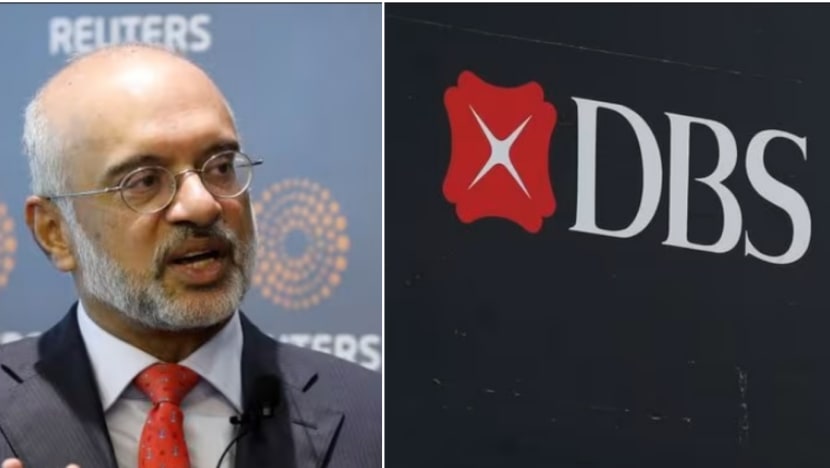DBS senior management taking accountability for service disruptions, starting with me: CEO Piyush Gupta
DBS chief Piyush Gupta said the move to hold senior management accountable by cutting their variable pay is "a good element of governance".

DBS CEO Piyush Gupta had his variable pay cut by 30 per cent in 2023 as a result of the digital disruptions experienced by the bank's customers. (Photos: Reuters)

This audio is generated by an AI tool.
- Mr Gupta took a 30 per cent cut to his variable pay
- About S$25 million has been spent on areas such as infrastructure and hiring consultants in order to boost the bank's technology and system resiliency
- Giving an example of improvements, the DBS chief says: "The service for mobile banking and PayLah! will be completely separate, which means that even if one goes down, the other should still continue to function."
SINGAPORE: With the cuts in their variable pay, DBS chief executive Piyush Gupta said on Wednesday (Feb 7) that the bank’s senior management team has shown that it is taking responsibility for the series of service disruptions last year.
The cuts were announced as part of DBS’ quarterly earnings results.
Mr Gupta took a deeper cut of 30 per cent, which amounted to S$4.14 million (US$3.08 million).
Collectively, the CEO and other members of the group management committee had their variable compensation reduced by 21 per cent from the previous year, despite the bank's record profits for 2023.
“We announced that we’re taking accountability at the senior management, starting with me, but also the rest of my senior management team. I think that's a good element of governance," Mr Gupta said at a results briefing on Wednesday morning.
“If you can establish accountability and figure that people take responsibility for making fixes, that's a good place to start. We’ve been able to demonstrate that and that’s obviously despite a record profit year,” he told reporters.
“Nevertheless, we decided to take collective responsibility for this.”
IMPROVING TECH RESILIENCY
DBS was hit by a string of disruptions to its digital banking services last year, prompting the Monetary Authority of Singapore (MAS) to bar the bank from any acquisitions of new business ventures for six months.
The bank was also required to pause non-essential IT changes for six months and was not allowed to reduce the size of its branch and ATM networks in Singapore.
DBS said then that it had set aside a special budget of S$80 million to enhance its technology and system resiliency.
About S$25 million has been spent so far on several areas, such as infrastructure, hiring of consultants and reallocation of resources, said Mr Gupta.
The bank has been focused on improving its technology across four key areas, namely technology risk governance and oversight, change management, system resiliency and recovery, as well as incident management process.
These efforts will enable the bank to better pre-empt disruptions to its services, provide customers with alternate channels for payments and account enquiries during disruptions, as well as shorten incident recovery time.
Some progress has been made, Mr Gupta told reporters.
For instance, the bank has made a few senior hires, such as in the areas of technology risk and risk audits, and is in the final stages of appointing a chief information officer.
To improve its system resilience and recovery, it is also looking at “eliminating single points of failure” by decoupling key services like mobile banking and DBS PayLah!.
“Somewhere in the backend, there is one machine which services both and therefore, you have the risk of both of them going down at the same time. We are now decoupling all those,” Mr Gupta said.
“So, the service for mobile banking and PayLah! will be completely separate, which means that even if one goes down, the other should still continue to function,” he explained, adding that this is likely to be completed by the first quarter.
Other steps it is taking include establishing a better escalation protocol among its various command centres and improving its real-time monitoring infrastructure. For the latter, it is doing so by increasing the number of variables being monitored and the analytics tools used to make sure it can pick up incidents “more speedily”.
DBS expects half of this technology action plan to be completed by the end of January. By the end of March, 90 per cent will be done.
“At this point, I'm quite confident that these actions will give us demonstrable outcomes and which customers will be able to see the benefits,” said the CEO of Southeast Asia's biggest bank.
“Having said that, it's not good to end there. Our commitment is to continue to allocate and dedicate resources towards resiliency efforts, even after that into the future.”
“SOLID” FOURTH QUARTER
On earnings, Mr Gupta said the bank had a “solid” fourth quarter, with net profit of S$2.39 billion. This is up from S$2.34 billion a year earlier, on the back of a 9 per cent increase in total income.
For the full year, the bank’s annual profit jumped 26 per cent to S$10.3 billion from S$8.19 billion in 2022. Return on equity climbed to a record high of 18 per cent from 15 per cent a year ago.
DBS has proposed a final dividend of 54 cents per share, an increase of six cents from the previous payout. This brings the ordinary dividend for the full year to S$1.92 per share, up 42 cents from the previous year.
In addition, the bank is proposing a one-for-10 bonus issue, meaning one bonus share for every 10 shares held.
The bonus shares will qualify for dividends, starting from the first-quarter 2024 interim dividend, and will increase the pace of capital returns to shareholders, the bank said.
“We decided to go for a bonus issue because it gives certainty into the future … but this doesn't mean that this is the end of our payment back to shareholders,” said Mr Gupta, adding that DBS continues to target an earlier guidance for a baseline annual increase of 24 cents a share for dividends.
“On top of that, I think we still have opportunity to do more specials or other forms of giveback,” he added.
“We will have greater confidence towards the middle of the year when we have a better line of sight on what's happening to interest rates and also hopefully some of our technology issues are behind us.”

















